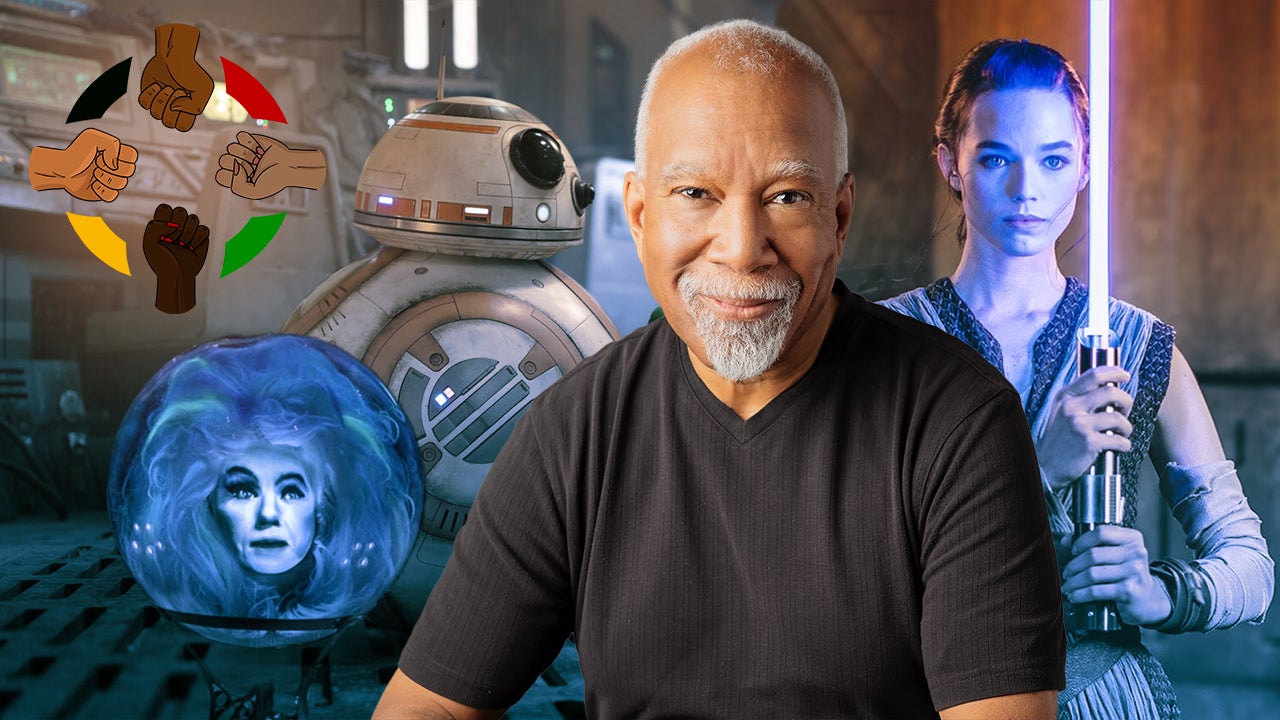Disney is filled with dreamers, yet there is one Imagineer who has had more dreams come true than most others who have been part of the company’s storied 100-year history. With 106 patents to his name and the honor of being the first Disney employee since Walt himself to be inducted into the National Inventors Hall of Fame, Lanny Smoot has been innovating for the studio for over 25 years, and he shows no sign of stopping anytime soon.
On the occasion of his induction into the National Inventors Hall of Fame and Black History Month, I had the chance to talk to Smoot about his long career, how he unknowingly helped create BB-8, the creation of the realistic lightsaber, his newest HoloTile floor invention that very well may change VR forever, and the advice he has for up and coming Black inventors.
A Spark That Would Light Up the Galaxy
Smoot was born in 1955 in Brooklyn, New York, and, as he told me, “grew up in poor circumstances but with loving parents.” This love from his family proved to outweigh any of the hardships that may have potentially derailed him as it put him on a path to success from a very early age.
One of Smoot’s earliest memories was when his father brought home a battery, an electric bell, and a lightbulb, and then wired them together so the bell would ring and the bulb would shine. That moment lit up so much more than the room as it was the spark that would open Smoot’s eyes to the endless and wondrous possibilities of science and engineering. And all it took was the love of a father who wanted to show his son just how incredible the world can be.
“The thing that lights that gift, that pushes it forward, is exposure,” Smoot said. “If my dad had not shown me the battery and bell thing, I might not be where I am today. Something else might have tripped it off as I clearly had a disposition for it, but if I'd never been exposed to it, it might've taken a lot longer.
“So, expose your kids. For Black parents, I will say specifically, expose your kids to everything you can. I know life can be hard, and some people are struggling just to make a living, but if you can make time for your kids just to take them to places they might not have ever been, it can change their lives.”
From that moment on, Smoot would continue to learn all he could and would go on to be selected as a Bell Labs Engineering Scholar and earn a full scholarship to Columbia University, work in the summer at Bell Labs, and then full-time employment with the company after he graduated.
During his time at Bell Laboratories and Bell Communications Research, Smoot began his journey of racking up dozens upon dozens of patents and was instrumental in the early development of video-on-demand technology, video conferencing, and more.
One of his most important patents, however, was for the Electronic Panning Camera prototype. This invention allowed people from home to change the angle of the television program they were watching at will, which in a sense gave them the power and feeling of being a director. The execs at Disney had great interest in this camera and, to make a long story short, representatives approached Smoot in 1998 and recruited him to join the company.
Since then, Smoot has earned over 74 patents at The Walt Disney Company and has brought the total patent count of his entire career to 106. Some of the highlights include giving Madame Leota the ability to “float” in the Séance Room at the Haunted Mansion, inventing the Magic Playfloor interactive game experience guests can enjoy on Disney cruises, producing the Fortress Explorations adventure at Tokyo DisneySea, and designing the gorgeous koi ponds at the Crystal Lotus Restaurant at Hong Kong Disneyland Hotel. Oh, and he was the one who designed the electrical circuitry that helped bring the Disney Infinity figures to life.
He also has a love for that galaxy far, far away and made one of his marks on the world of Star Wars by inventing the realistic, retractable lightsaber that made its debut at the now-closed Star Wars: Galactic Starcruiser. As you can see in the video below, this lightsaber is the closest example we have to the real thing and Smoot helped bring it to our very own Milky Way. And the story behind its creation is much simpler than you might think.
“Well, our former head of R&D, a fellow named Jon Snoddy, knew that we needed to have some sort of lightsaber as Star Wars was beginning its massive move into our parks,” Smoot said. “He asked a few of us, ‘Hey, do you have some ideas of how you might do this?’ I'm a bit of a show-off and I do like to show new technologies and surprise people, so I walked into his office and slammed something down on the table. I won't tell you exactly, but I will say it was pretty crude. He says, ‘That's pretty good,’ and the rest is history.”
Smoot also inadvertently helped create BB-8, although not in the way you might imagine. This story showcases the power of creating and putting yourself out there, as you never know where it may take you. Many Star Wars fans may know that Star Wars: The Force Awakens director J.J. Abrams famously drew the first image of BB-8 as a beautifully simple sketch of a ball with a little dome on top, but they may not know that one of Smoot’s patents from well before his time at Disney would help the little droid move and spin his way into our hearts.
“I invented the very same mechanism that BB-8 is, years before the movie was done, years before there was a BB-8,” Smoot said. “It was for another type of moving robot. There's an inside story that I can't quite tell you the whole of, but certainly, the one that is in the movies was done by the director and was not invented by me.
“However, I'll tell you the other side of this story,” Smoot said with a laugh. “BB-8 was developed by the London-based Creature Shop. That's who made the models that you see in the movies. As it turns out, we wound up licensing my design to help that design do certain things, so yeah, I guess I did help invent BB-8!”
Bringing Our Star Wars and Holodeck Dreams to Life
While Smoot is proud of all the work he’s done, the future is where he loves to be as that’s where the next great idea is laying in wait. One of these new ideas is the HoloTile floor, which very well may be a game changer for VR and could be the key to bringing the Holodeck from Star Trek to life.
The HoloTile floor was showcased alongside the announcement of Smoot’s induction into the National Inventors Hall of Fame and Disney described it as the “world’s first multi-person, omni-directional, modular, expandable, treadmill floor.” To boil it down, you can think of this floor as being made up of a ton of smaller tiles that all have a singular goal to keep whatever is on them in the middle of the larger floor. This, in theory, could allow people to “have a shared virtual reality (VR) experience, walk an unlimited distance in any direction, and never collide or walk off its surface.”
Virtual reality is meant to be incredibly immersive and bring you to worlds you never thought you could visit, but there is one huge problem that can quickly pull you out of, say, an experience like walking through the streets of The Black Spire Outpost on the planet of Batuu in Star Wars: Tales From the Galaxy’s Edge in VR.
“I think the HoloTile floor solves many of the problems that virtual reality has been looking at for years because it was always possible to insert you into an environment, but when you hit your bed as you're walking around in your room in VR glasses, you realize, ‘Hmm. There's something wrong here,’” Smoot said.
With the HoloTile floor, those worries are meant to disappear as you can live in these new worlds and even run through them without fear of smacking into a wall or TV and becoming the next viral YouTube video. As I alluded to above, this solution very much sounds like the Holodeck from Star Trek. For those unfamiliar, the Holodeck is a small-ish room that would transport our favorite crews to anywhere they wish to enjoy some fun and relaxation between mission.. This, according to Smoot, is one of the key inspirations for the HoloTile floor.
“Seeing the crew disembarking in the Holodeck and having some of them walk off to the mountains and some walk off to the lakes… ‘Wait! They're in a room that's 24 feet by 24 feet?! How is this possible?!’ You start thinking about it,” Smoot said, once again with a smile on his face. “They must be walking on a floor that can move anything on its surface in any direction instantaneously and et cetera, et cetera. So, there you go!”
What’s so special about the idea of the HoloTile floor is how much more it can be used for. In the reveal video below, we see an object being moved around by the tiles and a person’s arm extending in the corner of the screen seemingly controlling the object. As a massive Star Wars fan who has spent many hours trying to move a rock with the Force and will continue to do so until I do, the possibilities are very exciting.
“When we've demonstrated this to people who have not seen it before, they say that the ability to move an object at a distance has been one of the most fulfilling things they've ever done,” Smoot said. “You move it and you say, ‘My God. This is what telekinesis would be! This is moving things with your mind!’ I can't wait to see what happens if it's used in that way in our parks. Who knows, but it's exciting.”
It’s important to not get too excited yet as this is just a prototype and it may be some time until we see it in Disney Parks or our homes, but the promise of what this technology could bring, in addition to the applications it has for other entertainment fields like theater, where it can allow performers to “move and dance in new ways, or stage props and structures to move around or appear to set themselves up,” is spectacular.
A Brighter Future Awaits
Smoot loves inventing and bringing to life ideas that have never been thought of before, but what he loves just as much is helping others do the same and find a way for their dreams to come true, whatever that may be. As his father and mother did for him, he does all he can to be a role model for the next generation of brilliant inventors and, perhaps most importantly, for those Black children who he knows can be anything they set their mind to.
“For Black kids and people of color in general, and even for women still, they can be overlooked in terms of their amazing potential,” Smoot said. “What kids need most is an example, is exposure. My story, sure, I've got an ego, but the most important thing that I want young Black kids, young women, young people of color, LGBTQ folks, and everyone who feels a little bit left out to realize [is] they can do what I've done and so much more.”
As Smoot said in a video for the National Inventor’s Hall of Fame, “I believe everyone, every single person on this Earth, has a tremendous talent in something.” The key, however, is unlocking that potential and helping them find the road to becoming the remarkable person they can be.
“You can learn from me,” Smoot said. “I grew up poor. I grew up in a neighborhood that was fairly tough and I did things that were a little bit against the grain in terms of what other kids were doing. Sometimes that can be a little bit troubling, but the most important thing is to never give up. Treasure the things that you love, and do a lot of it.
“And again, early exposure is what lit me on fire, that made me want to do things. I think so many young kids don't have that exposure. Take your kids to a science museum. Take your kids to experience things that they would not have seen in other ways.”
Who knows, with the right exposure, they could even be the next Lanny Smoot, become the third Disney employee to be inducted into the National Inventors Hall of Fame, and even break his record for patents.
“Once a person like me does this, I know that it's just the beginning. When a record is made, it is inevitable that it will be broken. The next person will do it, and I'll be so proud,” Smoot said before laughing one more time. “But, maybe not too soon!”
For more Disney magic, you may also like to read more about the history of Disney, or see our visitor's guide to The Best Time to Visit Disney World.
Adam Bankhurst is a news writer for IGN. You can follow him on Twitter @AdamBankhurst and on Twitch.








